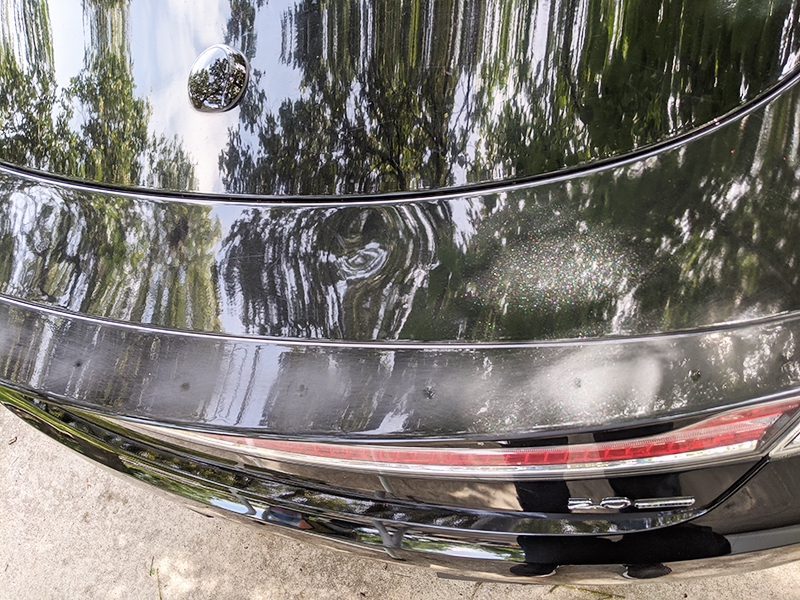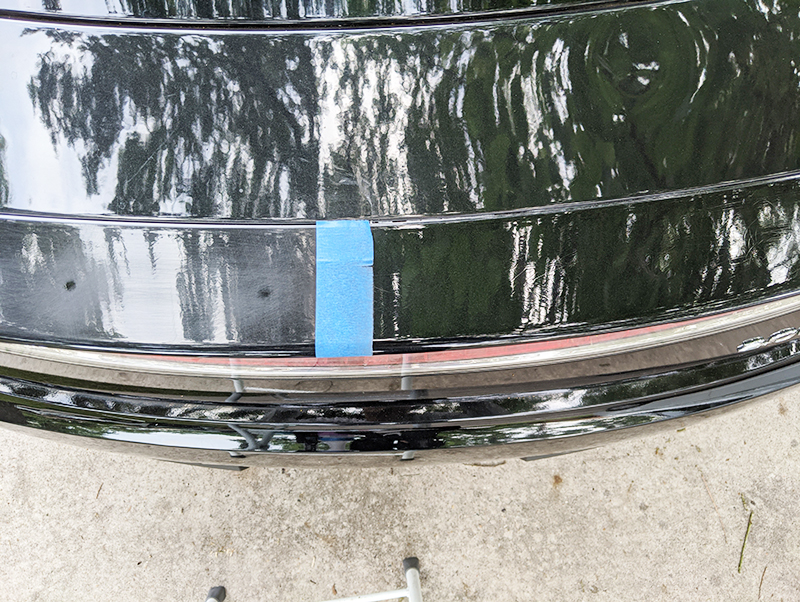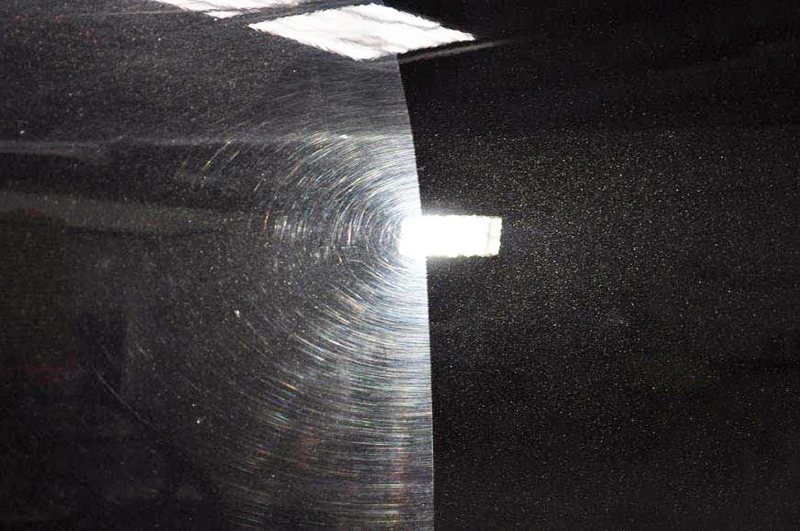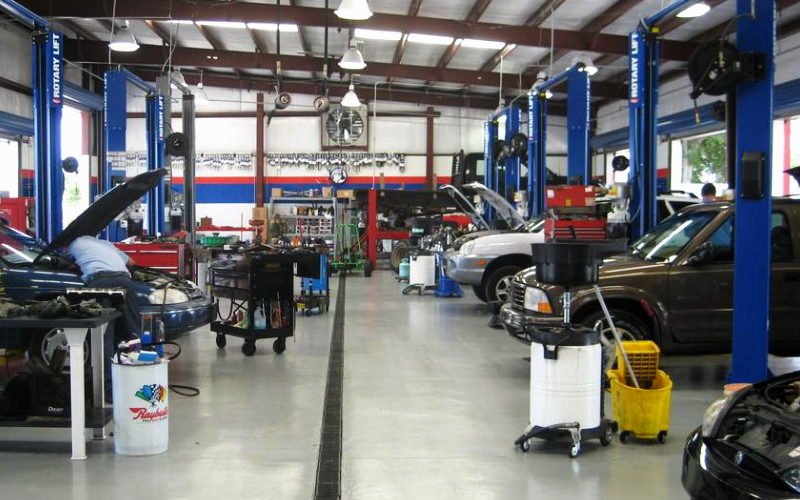Guide to Understand and Remove Spider Scratches from Car Paint
Have you ever notices spider scratches on the surface of your car? Spider scratches are a bone of content among cars, SUVs and truck owners because of their hideous appearance and bothersome light deflection. If you own a car, truck or SUV for long time, you are very likely to observe spider scratches on your car paint at some point.

Spider Webbing, Swirl Marks or Spider Scratches
Some other iterations of the term spider scratches include terms like spider webbing, swirl marks and dry pain scratches. No matter what you call them, it is true that spider scratches are nothing less than a root cause of inconvenience for many car owners. Unfortunately, these scratches appear on the car surface due to neglect, poor maintenance and prolonged, careless usage on part of the car owners.

It is a lengthy process to detect and chart down all the possible causes of spider scratches that appear on the paintwork of a car. However, the best part is that you can narrow this list down to major causes that lead to spider scratches and their solutions. Another important thing to consider are the ways to protect your car paint from future spider scratches once you are done with eliminating the existing spider scratches.
In this blog, we will be covering the major reasons that lead to formation of spider scratches, ways to get rid of them and how to prevent the spider scratches from occurring on your car paint in future.
Let’s learn more about spider scratches, shall we?
Understanding the Spider Scratches On a Car
A lot of misconceptions circulate in the automotive world regarding the understanding of spider scratches. In order to really understand the whole phenomenon of spider scratches on car paintwork, let’s compare our skin with the car’s paint. Just like our skin, the car’s paintwork depends upon the natural oils for proper hydration and reduce the potential of scratching on the surface.
Loss of Clear Coat due to UV exposure
Although the whole comparison may sound weird to you, it is one of the simplest ways to understand spider scratches. Our car’s body work receives hydration and protection from the clear coat. The clear coat is an additional layer of protection which is applied on the car paint to provide protection against UV radiation damages and loss of hydration due to other elements.
Due to prolonged UV exposure, the clear coat tends to lose its protective abilities since the molecules of the coat start to disintegrated. Over time, the affected area loses its ability to protect the paint work and loss of hydration takes place.
As the clear coat begins to dry, the formation of “dry pain” occurs. Although you may believe that this term is nothing more than a marketing jargon used by car wax sellers, the reality is that dry paint condition is pretty serious and real. Dry paint becomes more prone to scratching due to loss of protective layer and paint oils. With time, the paint starts to flake and results in the formation of spider scratches. The condition worsens if you fail to apply car wax after car wash at regular intervals. Car waxes are supposed to restore the hydrating/protective layer on the car paint.
Surface Damages Due to Contaminants
Another major factor that contributes to the formation of spider scratch on any car, SUV or truck’s paintwork are the contaminants that stick to the clear coat. In some cases, prolonged stains and rock chips serve as the starting points that accelerate the formation of spider scratches on the paintwork of many cars. One of the biggest contributors of spider scratch on car paint is the use of substandard towels to dry the car surface after cleaning or washing.
What is Meant by the Term “Spider Scratches?”
Unfortunately, a lot of wrong information is present on the internet regarding spider scratches. Many car owners have already paid thousands of bucks because of following rampant misinformation available on the internet on how to treat and eliminate the spider scratches. Keeping this in mind, there is a dire need to educate the car owners regarding the truth about spider scratches.
Spider scratches are irregular web-like anomalies observed on the surface of the car’s paintwork when you view it from a certain angle. Automotive spider scratches are a result of loss of lubricating abilities of the clear coat due to prolonged UV exposure. As a result of loss of lubrication from the clear coat, the car paint becomes more susceptible to scratches. The situation worsens to such as extent that even a microfiber cloth can lead to a lot of scratches on the surface of the car.
When it comes to the appearance of these scratches, the spider scratches appear in the form of spider webs which are present in circular pattern. The pattern will only reflect if you view the car surface from a certain angle under direct sunlight or illumination. Since most of these scratches are present on the flat car surface and impart an ugly effect to the look of the car, they can really bother many car owners.
Spider Scratches Vs. Swirl Marks – What’s the Difference?
The debate of how spider scratches and swirl marks differ from each other is long one. It is true that the visual appearance of both of these types of marks is quite similar. However, when you take a look inside the specification of both types of marks, you will be able to notice the subtle differences.
Swirl Mark
It is a very light, almost unnoticeable scratch present on the car surface. You can easily remove these marks by using a 3,000 grit sandpaper. Keep in mind that the typical cause of swirl marks is the use of orbital polishers. Swirl marks also appear due to a common car drying method that involves using car wax applicators which tend to use the wax-on-wax method and cotton towels. Swirl marks are easily observable on dark colored vehicles.
Spider Scratches
As far as spider scratches are concerned, the common cause of these scratches is the use of microfiber cloth to dry the car. Due to the repetitive and rigorous drying action, your car paint starts to dry and leads to the formation of dry pain spider scratches.
However, one of the easiest ways to prevent such types of scratches to apply a hydrated layer of clear coating or a natural wax. When you use advanced paint protection techniques like ceramic coating, the self-healing properties of the protective layer are good enough to prevent the development of spider scratches on the surface of your car. Just like the swirl marks, the spider scratches or spider webbing is highly observable on dark colored SUVs and other vehicles.
Main Causes of spider Webbing on Car Paint
Before we dive in to understanding the cause of spider scratches, let’s be clear on the fact that the CAUSE and SOURCE of spider webbing on cars are very different from each other. When the clear coat of your car loses its flexibility and self-healing power, it leads to a number of problems such as scratching formation of spider webs.
Cause of spider scratches
Essentially, the main cause of spider scratches is the loss of self-healing properties of the clear coat due to constant UV exposure, contaminants and acid rain. All these factors contribute to the drying effect in car paint and the clear coat loses it protective nature resulting in spider scratches.
Source/Activator of spider scratches
Your car’s damages clear coat will not lead to scratching unless an external force driven by the friction between the car surface and microfiber towels acts on the car. In other words, you can say that clear coat and paint work will remain dormant even when they are damaged unless they are scratches due to external forces of friction. The absence of ceramic coating, paint sealant, car wax and other protective products on car’s surface accelerates the scratching process and you tend to observe spider webbing on the car’s surface.
What Speeds up Car Drying Process?
Since we know that drying effect in car paint is the major culprit behind spider scratches, it is important to retard the factors that lead to accelerated drying paint effect in the cars. For starters, keep in mind that UV rays, sudden temperature change, prolonged exposure to sunlight during summers days, road salt, freezing temperatures in winter are all the factors that speed up the car paint drying effect. If you do not take preventive measures on time, you risk fracturing your car’s paint work. If this condition appears, you know that you will be spending thousands of dollars on a proper car body work and paint reapplication. Paint fracture can lead to:
- Loss in car value and resale price
- More susceptibility to rust and bodywork damages
- Bad outlook of the car and poor aesthetic appeal
- Big expenses needed to repair and restore the car
Tips to Reduce the Susceptibility of Spider Webbing on Car Paint
By now, you probably know that Car Spider Scratches are 100% avoidable. It is completely fine to neglect a problem about which you do not have clear formation. The same statement stands true for car owners in most cases. But the lack of knowledge is not a fair excuse to neglect your car’s care as there are plenty of resources to get help from. Coming to the matter of avoiding car scratches, let us tell you that you can reduce the susceptibility of car spider webbing by adopting the following ways
Apply a Protective Coat
Apply a protective layer just above your clear coat to protect your car’s paint from spider scratches. Clear Coats help in developing a protective layer against UV radiation damages and other drying effect factors so that your car’s paintwork can be preserved even after years of usage. Clear coats act as a shield to halt the penetration of contaminants deeper into the clear coat.
Use Natural Car Wax
Your car’s exterior surface needs hydration which can be provided by the application of protective oils. Natural car waxes, such as the Carnauba wax, are the best source of protective oils that help in restoring the self-healing properties and flexibility of car paint’s clear coats. Natural car waxes are effective for a few months only and eventually; waxes will harden under prolonged UV exposure. Thus, you will need to apply car wax on the car every now and then.
Invest in a Good Quality Car Sealant
Car Paint sealants are sunblock that protect the clear coat and paintwork. Applying an even layer of good quality paint sealant will not only help in blocking the harmful agents that cause paint cracking but also have a longer lifetime of almost one year.
Consider Ceramic Coating Solutions
The most advanced and promising technique to protect your car’s paint from spider webbing is to resort to the newly evolved ceramic coating car paint protection technique. Ceramic coating has the ability to seep into the microscopic imperfections present on the car paint and seal them for good. It restores the flexibility of car paint surface, blocks the UV radiation damages and eliminated spider webbing chances to a great extent.
Challenges in Removing Spider Scratches from a Car
Very Thin Scratches on Clear Coat
Just like swirl marks, the spider scratches are very thin and cut the clear coat of the paint. Unlike swirl marks, the spider scratches are not a cut but a cracking in the clear coat of the paint. The thin cut leads to the following challenges for car owners when it comes to removing spider scratches:
Complex Solutions
Swirl marks are easy to fix. All you need to do is purchase a good quality cutting compound, pour it on a microfiber cloth or orbital polisher and fix the marks. The process is pretty straightforward and highly effective. The cutting-compound acts to smooth out the clear coat surface near the marks leading to the elimination of swirl marks eventually.
However, in case of spider scratches, things are not that simple. In this case, the clear coat is cracking and you will need to remove the portion of affected clear coating to a point that desired smoothness is attained. Fixing spider scratches is a slow process that requires cutting pads of variable thickness and grit and aggressive cutting compounds.
When Are Spider Scratches Fixable?
Do Not Delay!
The minute you detect a spider scratches or spider webbing on the surface of your car paint, do not delay the repair. The longer the pain coat remains unprotected due to the flaking of clear coat, the more scratches will occur on the car surface. Eventually, the fix will get more and more complicated and it will be harder to resolve the problem.
Thumbnail Test
The general rule of thumb to check whether it is possible to fix spider scratches or not is to run your thumbnail across the scratch. If you hear a popping sound, you can deduce that the scratch is deep into the clear coat and it will require aggressive paint correction.
Steps for Removing Spider Scratches from Car Paint
Now that we have understood the basic knowledge about spider scratches, it is time to get straight to their solution. You can follow these steps to remove the spider scratches from your car’s paintwork:

Use a Cutting Compound
The main rule involved in removal of the spider scratches is to remove the clear coat down to the depth that is equal to the depth of the spider scratches. Use a clear cutting compound to gently remove the microscopic layers of clear coat until it attains a desired smoothness without damaging its ability to protect the car paint underneath.
Steps to Remove Spider Webbing and Swirl Marks
It is not recommended to perform the removal of on your own as this method involves patience along with expert “touch and feel” technique. It is best to leave the process to a professional auto detailer.
For DIY spider scratches removal, you must invest in a good quality cutting compound. After that, you can follow these steps carefully to remove spider scratches or swirl marks from car paint:
- Slap a considerable amount of cutting compound on the electric orbital polisher or a microfiber cutting pad
- Replace the cutting pad frequently – after doing the job on every 6 sq feet of section. Replacing the pad will help in preventing the digging of deeper than needed holes.
- Repeat the process on the entire vehicle till you can see a smooth clear coat which does not flake or show any scratches from any side or any angle
Tips to Protect Your Paint After Removing Spider Webbing
As much as the car webbing and car scratches are easily avoidable, you will be glad to know that you can prevent the chances of getting these ugly marks again on your car by adopting some preventive measures.
The cutting method used to fix car scratches is a good start to lead you in the right direction of fixing your car paint as well as to prevent it when everything is done. As stated earlier, responsible car owners are not just concerned about fixing problems at hand. Instead, they lay special emphasis on preventing those issues in future by putting proper car paint protection in place. Lack of proper car paint protection is the reason behind the formation of spider webs on the car in the first place.

Here are some of the best ways you can adopt to protect your car paint from spider webbing in future
Car Wax Paint Protection
Natural car waxes are a boon for automotive owners. The reason is that they are the easiest to prepare and apply products that offer good car paint protection against spider scratches. Invest in a good quality paste wax manufactured by a well-reputed bran as these pastes have higher concentration of natural oils required to hydrate and lubricate the clear coating of car and boost its self-healing properties. The only drawback of using natural car wax, like Carnauba wax, is that the its effectiveness will last for only a couple of months and you will have to repeat the process all over again.
Paint Protection Sealants
Paint Protection Sealants act as a hard shield that not only protects the car’s paintwork from UV radiation damages but also prevents the penetration of rock chips and other contaminants deep inside the car paint surface. You can use a synthetically created paint protection sealant to add a hard protective layer to eliminate the chances of spider webbing on your car’s paint work. Paint protection sealants are affordable but they are quite laborious and have a span of only one year.
Ceramic Coating for Car Paints
Ceramic coating is the most advanced and ultimate way of protecting your car’s paintwork from spider webbing and scratches. You can apply a layer of nano ceramic coating provided by Armor Shield IX to get supreme protection against the webbing scratches. The nano ceramic layers fills the imperfections of porous surfaces like headlights, clear coats, windshields and plastic materials to reinforce your car’s protective arsenal against the spider scratches.
Conclusion
In most cases, the main reason of car paint damage is the absence of protective layers and the use of substandard car washing products/methods. Even the automated car wash facilities harm the paint work of your car rather than restoring it. As a responsible car owner who values his investments, your best shot at prolonging the lifetime and look of your car is to apply paint protective layers such as paint sealants, car wax and ceramic coating that reduce the chances of car paint spider webbing scratches.
Spider scratches are 100% avoidable given that you pay proper attention to the protective layer present on top of your car paint.



